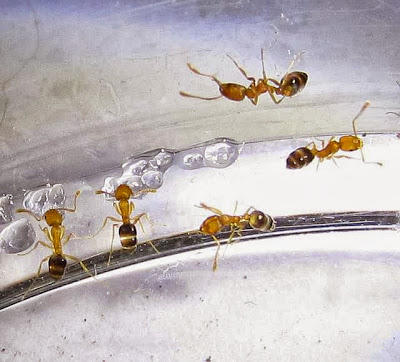Monomorium pharaonis is a pest ant that is ubiquitous to tropical South Asia. This species is commonly found in human habitation and structures. It is rarely found in the wild. The workers similarly to those of the pest ghost ant Tapinoma melanocephalum are often found floating on water surface in water containers where these ants get the water to keep the humidity in their nests which are usually in low moisture areas hidden in human habitation. Nests of Monomorium pharaonis are found among folded clothes, newspaper stacks, in and between books, inside electrical socket, under containers, in shoe boxes, etc.
There is very likely several strains (or sub species) within this genus with the most obvious morphological differences seen in the gyne or queen. Monomorium are monomorphic and polygynous. A colony typically have several sub nests that may span more than one building address.
Worker of Monomorium pharaonis
Worker of Monomorium pharaonis
Workers of Monomorium pharaonis
Workers of Monomorium pharaonis
Worker of Monomorium pharaonis
Queen of Monomorium pharaonis
Queen of Monomorium pharaonis
Queen of Monomorium pharaonis
Queen and worker of Monomorium pharaonis.
Monomorium pharaonis gyne and worker
Monomorium pharaonis queen and worker
Monomorium pharaonis queen and workers
Monomorium sp
This species which at first look (with my naked eye) I thought was Monomorium pharaonis as it was the near the same size and characterized by the same behavior and inhabiting in buildings.
But closer examination reveals that it is either a variant or an entirely different species of Monomorium which I have have provisioning tagged as Monomorium pseudopharaonis.
Monomorium pseudopharaonis secondary queens and workers. In these set of queens the thorax shows that these are secondary queens which never develop with wings and therefore incapable of participating in the nuptial swarming. Monomorium pharaonis reproduce new colonies both by swarming and by budding as is the case with most polygynous ants but this species does so entirely by budding as they do not produce (as far as I know) winged female alates.
Monomorium pseudopharaonis are characterized by their secondary queens. The workers approximately the same size as Monomorium pharaonis is differentiated by the gaster with prominent dark portion that nearly covers four fifth of the gaster. Another distinguishing characteristic is the post petiole node which is noticeably larger than the petiole.
Secondary queens are common in termites and ants though not all genera have them, even in genus that are polymorphic. These secondary queens are what I called non imago queens which may resemble queens but do not develop wings as part of their growth. Another species from this location with secondary (my definition) queens is Pristomyrmex pungens.
Ants from this location such as Leptogenys, Aenictus, Dorylus all have queens that do not develop into the imago stage common in insects. Of course there are insects that never have a true imago expression in their life cycle whether they undergo complete (such as wasp, bees, beetles, ants) or incomplete metamorphosis (such as grasshopper, cockroach, termites).
Workers of Monomorium pseudopharaonis
Workers of Monomorium pseudopharaonis
Workers of Monomorium pseudopharaonis
Workers of Monomorium pseudopharaonis
Workers of Monomorium pseudopharaonis
Workers of Monomorium pseudopharaonis
See also:
Monomorium
Momomorium destructor (Trichomyrmex destructor)
Monomorium floricola
Taxonomy:
No rank: cellular organisms 131567
Superkingdom (Domain): Eukaryota 2759
No rank: Opisthokonta 33154
Kingdom: Metazoa 33208
No rank: Eumetazoa 6072
No rank (Subkingdom): Bilateria 33213
No rank (Branch): Protostomia 33317
No rank (Infrakingdom): Ecdysozoa
No rank (Superphylum): Panarthropoda 88770
Phylum: Arthropoda 6656
No rank (Subphylum): Mandibulata 197563
No rank: Pancrustacea 197562
Subphylum (Epiclass): Hexapoda 6960
Class: Insecta 50557
No rank (Subclass): Dicondylia 85512
Subclass (Infraclass): Pterygota 7496
Infraclass: Neoptera 33340
Cohort: Holometabola
Order: Hymenoptera 7399
Suborder Apocrita 7400
Infraorder: Aculeata 7434
Superfamily: Formicoidea
Family: Formicidae 36668
Subfamily: Myrmicinae 34695
Tribe: Solenopsidini 144017
Genus: Monomorium 55077
Species: pharaonis 307658
Last Updated: 2021 09 03
First Posted: 2013 06 06
© 2009 – 2021 Quah. All rights reserved.
































